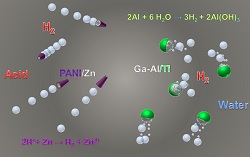 |
| A microrocket that runs on stomach acid could help deliver drugs.--Courtesy of Wei Gao |
Nano-scale drug delivery vehicles often rely on passive diffusion to get drugs to their target. But researchers at the University of San Diego are taking a more active approach, with self-propelled "microrockets" that could enhance drug delivery for cancer.
While the development of microrockets has taken several forms over the years--such as hydrogen peroxide-fueled and magnet-driven versions--Joseph Wang and his team have created a micromotor that uses material in its surrounding environment as a means of propulsion.
An active as opposed to a passive approach to delivery gives the drugs a higher rate of penetration as they delve into deeper parts of a tumor, leading to a more effective treatment, the researchers say.
 |
| The chemical reactions behind microrocket propulsion--Courtesy of Wei Gao, Joseph Wang |
The scientists created several types of rockets: one that runs on stomach acid, another that runs on water and a third that can use multiple kinds of fuel, according to a release from the American Chemical Society. The vehicles made of zinc react with hydrochloric acid in the stomach to propel them with tiny bubbles at a speed of 100 times their length in a second, the fastest of their kind.
Additionally, aluminum and gallium versions of the nanocarriers react with water, which is a fuel readily available in the human body. The final aluminum particle is suited for a broad range of fuels, such as acids, bases and hydrogen peroxide, Wang said in a statement.
"The use of biocompatible fuels is attractive for avoiding damage to healthy tissue in the body," Wang said. "We envision that these machines could someday perform microsurgery, clean clogged arteries or transport drugs to the right place in the body."
With funding from the National Science Foundation and the U.S. Department of Energy, Wang and his team are looking to extend the microrockets' release time and making them more specifically compatible with certain drugs.
- here's the release